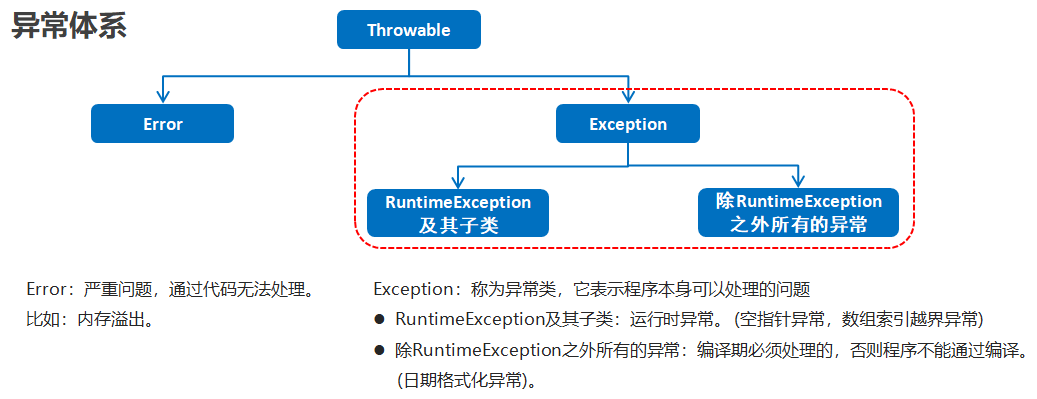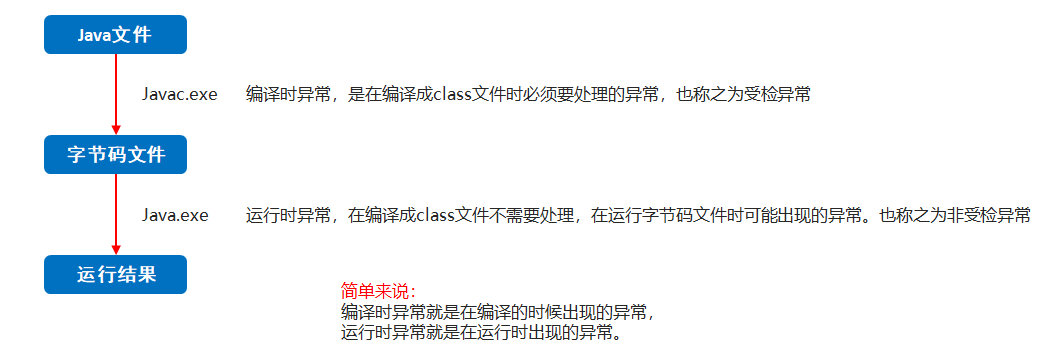包装类
基本类型包装类
作用
将基本数据类型封装成对象的好处在于可以在对象中定义更多的功能方法操作该数据
常用的操作之一:用于基本数据类型与字符串之间的转换
基本类型对应的包装类
基本数据类型 包装类 byte Byte short Short int Integer long Long float Float double Double char Character boolean Boolean
Integer类
包装一个对象中的原始类型 int 的值
Integer类构造方法
| 方法名 | 说明 |
|---|---|
| public Integer(int value) | 根据 int 值创建 Integer 对象(过时) |
| public Integer(String s) | 根据 String 值创建 Integer 对象(过时) |
| public static Integer valueOf(int i) | 返回表示指定的 int 值的 Integer 实例 |
| public static Integer valueOf(String s) | 返回一个保存指定值的 Integer 对象 String |
自动拆箱和自动装箱
自动装箱
把基本数据类型转换为对应的包装类类型
自动拆箱
把包装类类型转换为对应的基本数据类型
示例代码
Integer i = 100; // 自动装箱 i += 200; // i = i + 200; i + 200 自动拆箱;i = i + 200; 是自动装箱
int和String类型的相互转换
int转换为String
转换方式
- 方式一:直接在数字后加一个空字符串
- 方式二:通过String类静态方法valueOf()
示例代码:
public class IntegerDemo {
public static void main(String[] args) {
//int --- String
int number = 100;
//方式1
String s1 = number + "";
System.out.println(s1);
//方式2
//public static String valueOf(int i)
String s2 = String.valueOf(number);
System.out.println(s2);
System.out.println("--------");
}
}- String转换为int
转换方式
- 方式一:先将字符串数字转成Integer,再调用valueOf()方法
- 方式二:通过Integer静态方法parseInt()进行转换
示例代码:
public class IntegerDemo {
public static void main(String[] args) {
//String --- int
String s = "100";
//方式1:String --- Integer --- int
Integer i = Integer.valueOf(s);
//public int intValue()
int x = i.intValue();
System.out.println(x);
//方式2
//public static int parseInt(String s)
int y = Integer.parseInt(s);
System.out.println(y);
}
}数组二分查找样例
public class BinarySearchDemo {
public static void main(String[] args) {
int [] arr = {1,2,3,4,5,6,7,8,9,10};
int number = 11;
int index = binarySearchForIndex(arr,number);
System.out.println(index);
}
private static int binarySearchForIndex(int[] arr, int number) {
int min = 0;
int max = arr.length - 1;
//2.循环查找 min <= max
while(min <= max){
int mid = (min + max) >> 1;
if(arr[mid] > number){
max = mid -1;
}else if(arr[mid] < number){
min = mid + 1;
}else{
return mid;
}
}
//如果min大于了max就表示元素不存在,返回-1.
return -1;
}
}Arrays
- Arrays的常用方法
| 方法名 | 说明 |
|---|---|
| public static String toString(int[] a) | 返回指定数组的内容的字符串表示形式 |
| public static void sort(int[] a) | 按照数字顺序排列指定的数组 |
| public static int binarySearch(int[] a, int key) | 利用二分查找返回指定元素的索引 |
- 示例代码
public class MyArraysDemo {
public static void main(String[] args) {
// public static String toString(int[] a) 返回指定数组的内容的字符串表示形式
// int [] arr = {3,2,4,6,7};
// System.out.println(Arrays.toString(arr));
// public static void sort(int[] a) 按照数字顺序排列指定的数组
// int [] arr = {3,2,4,6,7};
// Arrays.sort(arr);
// System.out.println(Arrays.toString(arr));
// public static int binarySearch(int[] a, int key) 利用二分查找返回指定元素的索引
int [] arr = {1,2,3,4,5,6,7,8,9,10};
int index = Arrays.binarySearch(arr, 0);
System.out.println(index);
//1,数组必须有序
//2.如果要查找的元素存在,那么返回的是这个元素实际的索引
//3.如果要查找的元素不存在,那么返回的是 (-插入点-1)
//插入点:如果这个元素在数组中,他应该在哪个索引上.
}
}- 工具类设计思想
- 构造方法用 private 修饰
- 成员用 public static 修饰
异常处理

编译时异常和运行时异常的区别
编译时异常
- 都是Exception类及其子类
- 必须显示处理,否则程序就会发生错误,无法通过编译
运行时异常
- 都是RuntimeException类及其子类
- 无需显示处理,也可以和编译时异常一样处理

JVM默认处理异常的方式
语法错误不在异常范围内
当代码出现异常,就在这里创建一个异常对象。
如果程序出现了问题,而我们没有做任何处理,最终JVM 会做默认的处理,处理方式有如下两个步骤:
把异常的名称,错误原因及异常出现的位置等信息输出在了控制台
程序停止执行
查看异常信息
控制台在打印异常信息时,会打印异常类名,异常出现的原因,异常出现的位置
我们调bug时,可以根据提示,找到异常出现的位置,分析原因,修改异常代码
异常处理方式
定义格式
public void 方法() throws 异常类名 { }这个throws格式是跟在方法的括号后面的
编译时异常必须要进行处理,两种处理方案:try…catch …或者 throws,如果采用 throws 这种方案,在方法上进行显示声明,将来谁调用这个方法谁处理
运行时异常因为在运行时才会发生,所以在方法后面可以不写,运行时出现异常默认交给jvm处理
throw抛出异常
格式
throw new 异常();
注意
这个格式是在方法内的,表示当前代码手动抛出一个异常,下面的代码不用再执行了
throws和throw的区别
throws throw 用在方法声明后面,跟的是异常类名 用在方法体内,跟的是异常对象名 表示声明异常,调用该方法有可能会出现这样的异常 表示手动抛出异常对象,由方法体内的语句处理
- 示例代码
public class ExceptionDemo8 {
public static void main(String[] args) {
//int [] arr = {1,2,3,4,5};
int [] arr = null;
printArr(arr);//就会 接收到一个异常.
//我们还需要自己处理一下异常.
}
private static void printArr(int[] arr) {
if(arr == null){
//System.out.println("参数不能为null");
throw new NullPointerException(); //当参数为null的时候
//手动创建了一个异常对象,抛给了调用者,产生了一个异常
}else{
for (int i = 0; i < arr.length; i++) {
System.out.println(arr[i]);
}
}
}
}try-catch方式处理异常
定义格式
try { 可能出现异常的代码; } catch(异常类名 变量名) { 异常的处理代码; }执行流程
- 程序从 try 里面的代码开始执行
- 出现异常,就会跳转到对应的 catch 里面去执行
- 执行完毕之后,程序还可以继续往下执行
示例代码
public class ExceptionDemo01 { public static void main(String[] args) { System.out.println("开始"); method(); System.out.println("结束"); } public static void method() { try { int[] arr = {1, 2, 3}; System.out.println(arr[3]); System.out.println("这里能够访问到吗"); } catch (ArrayIndexOutOfBoundsException e) { System.out.println("你访问的数组索引不存在,请回去修改为正确的索引"); } } }注意
如果 try 中没有遇到问题,怎么执行?
会把try中所有的代码全部执行完毕,不会执行catch里面的代码
如果 try 中遇到了问题,那么 try 下面的代码还会执行吗?
那么直接跳转到对应的catch语句中,try下面的代码就不会再执行了
当catch里面的语句全部执行完毕,表示整个体系全部执行完全,继续执行下面的代码如果出现的问题没有被捕获,那么程序如何运行?
那么try…catch就相当于没有写.那么也就是自己没有处理.
默认交给虚拟机处理.同时有可能出现多个异常怎么处理?
出现多个异常,那么就写多个catch就可以了.
注意点:如果多个异常之间存在子父类关系.那么父类一定要写在下面
Throwable成员方法
- 常用方法
| 方法名 | 说明 |
|---|---|
| public String getMessage() | 返回此 throwable 的详细消息字符串 |
| public String toString() | 返回此可抛出的简短描述 |
| public void printStackTrace() | 把异常的错误信息输出在控制台 |
- 代码实例:
public class ExceptionDemo02 {
public static void main(String[] args) {
System.out.println("开始");
method();
System.out.println("结束");
}
public static void method() {
try {
int[] arr = {1, 2, 3};
System.out.println(arr[3]); //new ArrayIndexOutOfBoundsException();
System.out.println("这里能够访问到吗");
} catch (ArrayIndexOutOfBoundsException e) { //new ArrayIndexOutOfBoundsException();
// e.printStackTrace();
//public String getMessage():返回此 throwable 的详细消息字符串
// System.out.println(e.getMessage());
//Index 3 out of bounds for length 3
//public String toString():返回此可抛出的简短描述
// System.out.println(e.toString());
//java.lang.ArrayIndexOutOfBoundsException: Index 3 out of bounds for length 3
//public void printStackTrace():把异常的错误信息输出在控制台
e.printStackTrace();
// java.lang.ArrayIndexOutOfBoundsException: Index 3 out of bounds for length 3
// at com.itheima_02.ExceptionDemo02.method(ExceptionDemo02.java:18)
// at com.itheima_02.ExceptionDemo02.main(ExceptionDemo02.java:11)
}
}
}自定义异常
自定义异常概述
当Java中提供的异常不能满足我们的需求时,我们可以自定义异常
实现步骤
- 定义异常类
- 写继承关系
- 提供空参构造
- 提供带参构造
代码实现
学生信息录入,要对年龄进行判断。
异常类
public class AgeOutOfBoundsException extends RuntimeException { public AgeOutOfBoundsException() { } //提供空参构造 public AgeOutOfBoundsException(String message) { super(message); } //提供带参构造 }学生类
public class Student { private String name; private int age; public Student() { } public Student(String name, int age) { this.name = name; if(age >= 18 && age <= 25){ this.age = age; }else{ //如果Java中提供的异常不能满足我们的需求,我们可以使用自定义的异常 throw new AgeOutOfBoundsException("年龄超出了范围"); } } public String getName() { return name; } public void setName(String name) { this.name = name; } public int getAge() { return age; } public void setAge(int age) { if(age >= 18 && age <= 25){ this.age = age; }else{ //如果Java中提供的异常不能满足我们的需求,我们可以使用自定义的异常 throw new AgeOutOfBoundsException("年龄超出了范围"); } } @Override public String toString() { return "Student{" + "name='" + name + '\'' + ", age=" + age + '}'; } }测试类
public class ExceptionDemo12 { public static void main(String[] args) { // 键盘录入学生的姓名和年龄,其中年龄为 18 - 25岁, // 超出这个范围是异常数据不能赋值.需要重新录入,一直录到正确为止。 Student s = new Student(); Scanner sc = new Scanner(System.in); System.out.println("请输入姓名"); String name = sc.nextLine(); s.setName(name); while(true){ System.out.println("请输入年龄"); String ageStr = sc.nextLine(); try { int age = Integer.parseInt(ageStr); s.setAge(age); break; } catch (NumberFormatException e) { System.out.println("请输入一个整数"); continue; } catch (AgeOutOfBoundsException e) { System.out.println(e.toString()); System.out.println("请输入一个符合范围的年龄"); continue; } } System.out.println(s); } }

